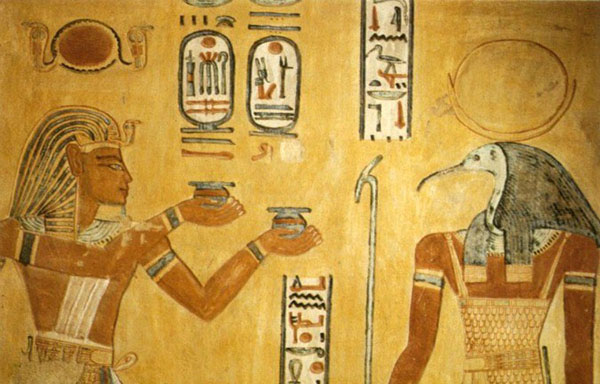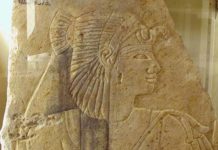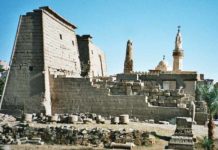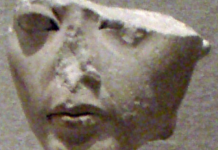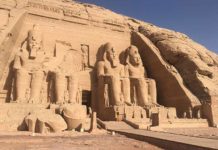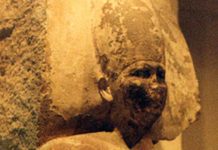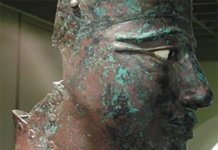Religion stayed remarkably constant throughout the 3,000 years from the Old kingdom through to the arrival of Christianity in the Roman period. The fervor behind religious practice lay in keeping the divine order in motion and in defending life and order from chaos. Knowledge of the various gods and goddesses come from rituals and texts that were to defend the individual in life and the afterlife.
The Old Kingdom Gods
There are not great tales about the gods like in Roman and Greek mythology; rather there are only allusions to the gods and their roles. Egyptian deities can be split into separate parts but remain a central figure. For example, Khons-in-Thebes and Khons-the-child merge together to form a compound deity of Amun-Ra.
From the early period of the Old Kingdom there is talk of the creator, most closely associated with the sun. The Egyptian myth of creation is like that which happens to their precious Nile every year when the land emerges covered with fresh silt after every flood.
Egyptian Temples
Every new temple built was seen as representing creation itself and the raised ground under the sanctuary was considered to be the primeval mound of creation. The main temple of the sun was in Helipolis. Inside was a sacred stone called benben in the shape of a pyramid.
Benbenet was the name given to the capstone of a pyramid. The benu, a bird like a heron would fly from the newly found solid ground of the flood in a symbol of creation. In a similar story, a creator-god as a youth would appear out of a lotus flower to bring the breath and scent of life.
Heliopolis
At Heliopolis the sun god was named Atum meaning ‘the all’, which symbolized a completeness of matter that superseded the other gods. He was pharaoh as a human wearing the Double Crown of the two lands.
Atum was male and created another generation of deities including Shu, a preserving force of dry air and light and Tefnut, the corrosive force of moisture. He created these by a partnership with a female counterpart called Iussaas or Heka. Iussaas had a place at the temple in Heliopolis also and was called Nebethetepet or the mistress of Hetepet.’
Second Generation of Gods
There was a third generation of gods to follow on the second; from Shu and Tefnut came the earth Geb and the sky Nut. The latest generation of gods and probably the most easily recognized now was Osiris and his wife Isis and Seth and his wife Nephthys.
About these deities the Egyptians did leave many stories and about Isis and Osiris’ son Horus. The first nine deities from Atum to the children of Geb and Nut were called the Nine of Heliopolis or Ennead and dominate literature from the Pyramid texts of the Old Kingdom until the Roman period.
Before the Creation Story
There were also beliefs concerning what happened before the creator, Atum. There was said to be ‘the Eight’ who were present at the appearance of the primeval mound. In the Middle Kingdom they were said to be Nun and Nenet, god and goddess of the primeval waters, Heh and Hehet, god and goddess of eternity; Kek and Keket, god and goddess of darkness and Tenem and Tenemet, god and goddess of twilight. From these eight Atum was created.
Creation Story
In order to create something out of nothing Atum relied on three forces. The first was Heka the magical force of creativity. He used Sia ‘perception’ to find a goal which was fulfilled through Hu, the divine word.
The Egyptians worshipped creativity in other ways not related to the creation itself. The god Min was worshipped as a symbol of masculine fertility, whilst Khnum was said to be the god of creativity through pottery. His temple stood on the Elephantine in the south of Egypt.
He also became responsible for the fertility brought by the silt out of which pottery was made and from which crops grew. Satet was the wife of Khnum and the huntress of gazelles Anuket joined them to form a triad that was typical of Egyptian religion from the New Kingdom to the Roman period.
Ptah
Ptah symbolized the source of power and was the god of metalwork. His main worshipping location was in Memphis, the Old Kingdom capital, where the main workshops were. This craftsmanship would stretch not just to the making of metal tools but to the use of them also for example in cutting building blocks or fashion sculpture. Ptah was therefore also a patron of arts and crafts.
Source:
- The British Museum Book Of Ancient Egypt, British Museum Press, London, 2007.


